Apologies for the slightly crooked scan. Interesting that the lesson here refers back to the previous one, which was nothing like it. Quality control in Golden Age comics wasn’t the greatest…
Comix
Showcase Sunday: Bat Lash
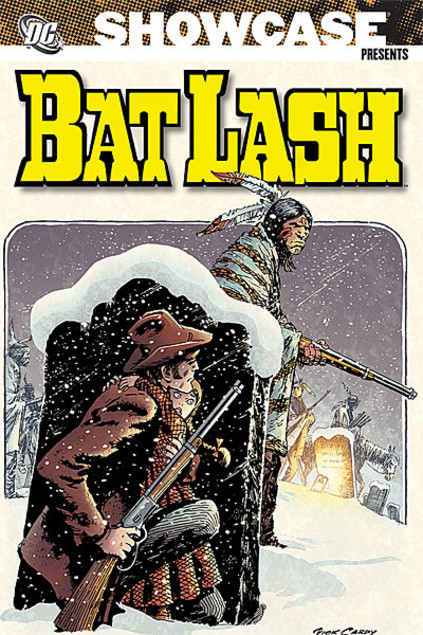
Showcase Presents: Bat Lash
Sergio Aragones, Nick Cardy, Denny O’Neil and friends
Reprints Showcase #76, Bat Lash #1-7, DC Special Series #16 & Jonah Hex #49, 51 & 52
Get this for: Nick Cardy art going from full on cartoonish to spaghetti western realist in two panels
Having now read through several of Showcase volumes of early sixties DC Silver Age series, I felt it was time for a break. Important as those series are, they do suffer from the fact that these were never meant to read through in one sitting, with many of the stories being variations on a theme, the same ones cropping up again and again. What I needed instead wasn’t yet another huge 500+ page wodge, but something slim and slightly more complex. The collected Bat Lash was perfect.

By 1968, when Bat Lash made his first appearance, in Showcase of course, comics was very different from where it was at the start of the sixties. The Silver Age revolution DC had unleashed had been taken up by Marvel with great enthusiasm and while DC might still be selling more comics than them, all the excitement was at Marvel. Unlike DC, Stan Lee and co had aimed their comics at a more adult readership, making both their heroes’ morals and stories slightly more complicated than the goody two shoes world of DC, not helped by the latter’s bureaucratic ways of working. By the end of the decade though DC was working hard to catch up with Marvel, Bat Lash being one of the results of this improvement drive.
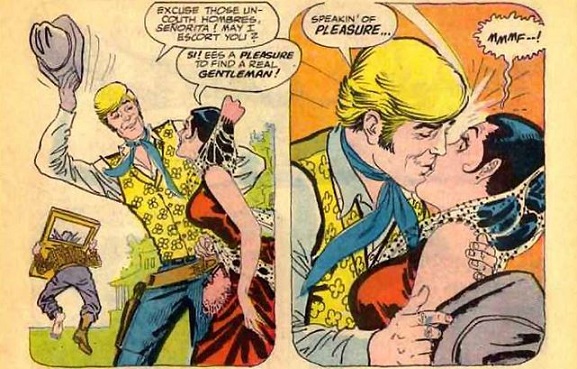
Bat Lash was a very different sort of western hero. A dandy and a scoundrel, he had a taste for the finer things in life, especially if those finer things were female and at times he might as well have been wearing a fedora instead of a stetson; he’s portrayed as a little bit too grab handey at times, though of course every woman he puts the moves on ends up liking it very much, except when they have their own nefarious designs. Bat Lash was the creation of an unlikely duo: Sergio Aragones, much better known for his humouristic, big footed work for Mad and Groo the Warrio and artist Nick Cardy, best known for his Aquaman and Teen Titans art, with Denny O’Neil helping with the scripting after his first appearance.
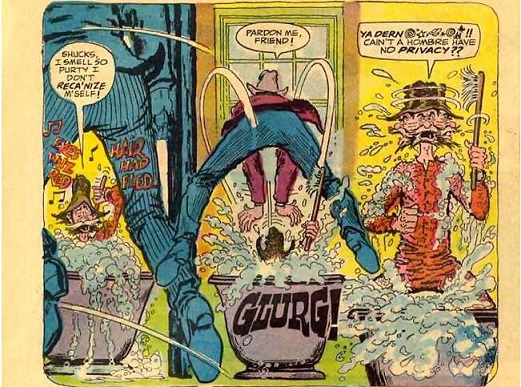
Most of the stories here follow the same pattern: open with Bat Lash in peril, only to saved at the last moment by the woman he got into trouble for, then riding out of whichever town he was in to get involved in some sort of adventure in which his avarice has to combat his well buried better nature. These then are still fairly formulaic stories, but much more interesting and with some continuity between them, with our hero crossing the border into Mexico in one issue and attempting to get out in the next.
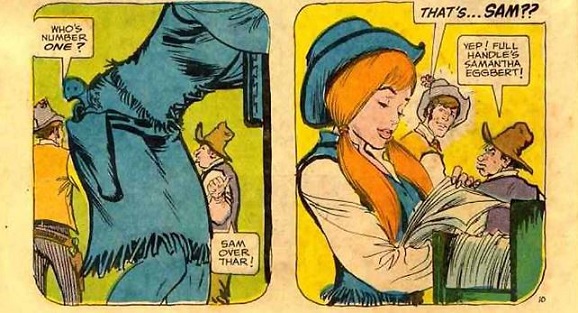
What really makes the original Bat Lash series is Nick Cardy’s artwork, some of the best he’s ever done. Just look at the Showcase cover above, originally done for issue two: that’s a brilliantly done scene, telling a story with one picture. Cardy has a real affinity for drawing the old west and is great at action scenes as in that first sequence showing Lash being ambushed and turning the tables on his ambusher. But he also does well with humour, which turns up a lot in these stories, as in the sequence where Bat Lash has to escape from his hotel by fleeing through some old-timer’s bath. It’s clearly the same artwork, just a bit more exaggerated. And of course Cardy also has his usual flair with drawing women, who have a heft and physicality to them that’s rare for that time, especially at DC. Plenty of artists that could draw pretty girls, but Cardy’s are real women. In black and white his artwork looks even better than when it’s coloured.

Sadly the original series only lasted seven issues, which is barely long enough to have gotten the sales figures for the first issue in. Since then he’d been wandering around the edges of DC’s western titles and this volumes includes some of his later appearances, which aren’t bad, but without Aragones or Cardy onboard, lack the charm of the original. A pity too that in that very last issue, after the previous one had featured his origin, Lash runs across a bounty hunter with gunslinging skills as good and perhaps even better as his own, out for his blood and who might just be his younger brother, a storyline that was ended just as it begun…
Saga — Best Graphic Story Hugo
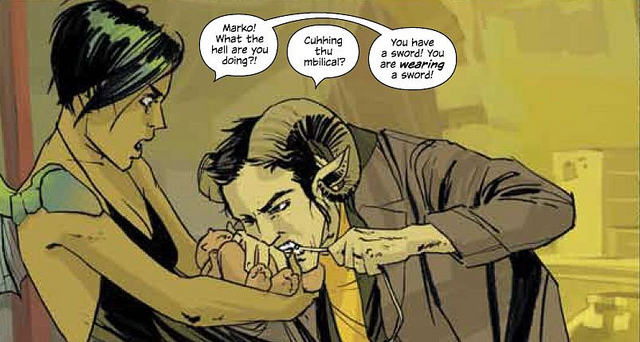
Saga has already won the Best Graphic Story Hugo once, in 2013, for the first volume of the series. I think the review I did of that first volume back then also goes for the third volume:
What makes Saga more than just a pretty sci-fi adventure is the simple fact that none of the main characters are true villains or heroes. Alana and Marko just want to live in peace with their daughter, to be left alone, while Prince Robot IV just want to get things over with so he can go home to his pregnant wife. Even the two freelancers are anything but Boba Fett like bounty hunters, with The Will frex having confliced feelings about his former partner, The Stalk.
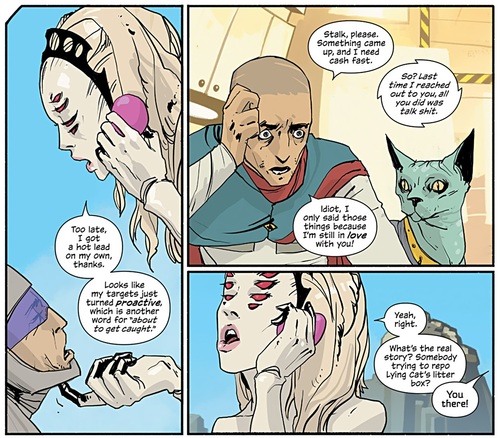
But what really makes the series is the artwork; as said Staples is seriously good at facial expressions, slightly exaggerated at key moments, but also has a good eye for character design and layout in general. In general, like Prophet, this is a series that actually makes me enthusiastic about American comics again, something that shows there are still pleasant surprises to be had.
The only thing worth adding to this is that being the third volume, this is less of a complete story than the first, starting and ending in media res. I went back and forth on whether this or Ms. Marvel was the better comic, but though Saga is more properly science fiction, Ms. Marvel was done slightly better and perhaps the more important comic.
Ms. Marvel — Best Graphic Story Hugo

I already looked at Ms Marvel back in February:
Put it all together and you have a comic that is a decent, well crafted superhero comic that puts its focus firmly on what Marvel has always done better than anybody else, showing their heroes’ complicated home lifes inbetween the battle royales. But the main significance of Ms. Marvel is who she is and that Marvel is comfortable publishing a Muslim written comic starring a Muslim superhero, that’s respectable about the culture Kamala Khan comes from and represents, but not afraid to show conflict either. It doesn’t devolve into cliches about oppression and Islam and all that while still showing a teenager chafing at the rules laid on her by authority figures — parents, teachers, religious leaders. It is essential Marvel teen hero stuff, reinvented for the 21st century.
If you don’t mind classifying a superhero comic as science fiction, this is the best of the lot, a 21st reinvention of Spider-Man and the Marvel teen hero. Remember, the original Marvel series from Fantastic Four #1 onwards were rooted in a spirit of rebellion, from the moment Reed set out to steal that moon rocket despite the authorities warning him about it. Then of course there was Spider-Man, hated and feared by the people he saves, branded an outlaw by The Daily Bugle and still doing what is right because “with great power comes great responsibility”. Marvel heroes have always had a bit of a tense relationship with official authorities, not entirely in opposition but not blindly trusting them either, not in that godawful libertarian sense that outsiders might want to spin it as, but with a healthy dose of skepticism and faith in their own judgment.
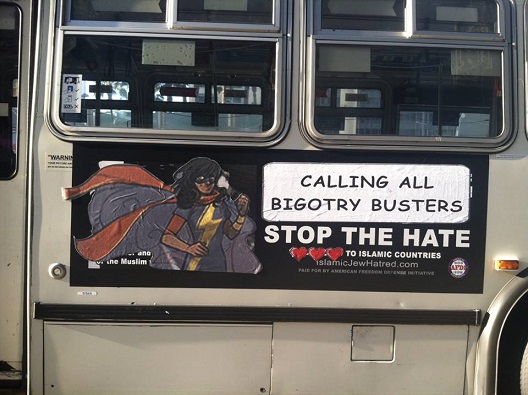
That sort of disappeared after 2000, in the Bush era, as Marvel allowed itself to be swept up in the War on Terror hysteria and a new generation of writers bought into that semi-fascist view of superheroes as enforcers of the status quo, unfettered by due process, culminating in the hideous Civil War crossover which saw Iron Man run his own Abu Ghraib style gulag in the Negative Zone and in which Captain America lost because he didn’t know about Myspace. Suddenly every superhero was now part of SHIELD or similar paramilitary organisations and it went against everything Marvel used to stand for.
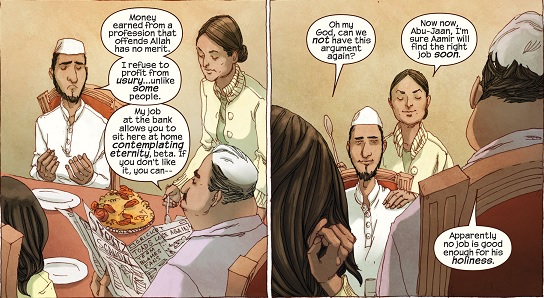
Ms. Marvel is a refutation of all that idiocy, somebody whose background gives her good reasons to be skeptical of authority even before gaining superpowers, who chafes at the restrictions her parents and culture put upon her but who also is keenly aware that her family loves and cares for her. She’s a teenager growing up and testing her boundaries, but like Peter Parker before her, she has a good head on her shoulders and knows her right from wrong.
Now for the most part I don’t think superhero comics should be nominated for the Hugos, as I consider superheroes to be a separate genre from either fantasy or science fiction. But since it has been nominated, I’ll vote for it and put it first on my ballot, as of the four entries it’s the best and most important for its own story and for what this series says about Marvel in 2014/15. G. Willow Wilson is a great writer, a non-traditional writer for Marvel and Adrian Alphona is a brilliant artist for a series whose hero has mighty morphin powers.
Preliminary thoughts — Best Graphic story Hugo
During the various discussions about the Puppies, the Hugo Awards and everything somebody, I think it was Erik Olson, made the excellent remark that new Hugo categories only make sense if there are enough good candidates each year for it. If there only one or two or even five different candidates in any given year, what’s the point? It occurred to me that the converse is also true: any given Hugo category only makes sense if the Hugo voters are knowledgeable enough to actually vote for more than just a handful of the usual subjects year after year. Otherwise it means you just have an even smaller than usual group of people nominating and most people either not voting, or only voting for names they recognise.
The Best Graphic Story category, which was first awarded in 2009, at first seemed to fail that second requirement. The first three awards were won by Girl Genius and you do wonder whether that was because people recognised Kaja & Phil Foglio from fandom, rather than for the comic itself. The Foglios themselves were gracious enough to withdraw after their third win and since then the category has improved a lot, having been won by three different comics since. I’m still a bit skeptical of how well it will work out in the long term, or whether it’ll become just another category most people won’t care about, like the best semi-prozine or best fan artist ones and just vote by rote, if at all.
On the other hand though, if there’s one thing the Hugos, as well as Worldcon needs if it wants to stay relevant, is to get in touch with wider fandom, to not just focus on the old traditional categories. And comics suit the Hugos well. There are plenty of science fiction comics published each year, even omitting superhero series and there does now seems to be a core of Worldcon fans invested in nominating and voting. Since there isn’t really a proper comics orientated sf award yet, haivng the Hugos take up the slack is an opportunity to make them relevant to a primary comics geek, as opposed to a written sf geek audience.
Now it may surprise you, but I’m a bit of a comics nerd myself, if not as fanatical as fifteen years ago, picking up most of my reading in trades. The Best Graphic Story category is eminently suitable for this sort of reading, as it also tends to focus on trades and collections rather than ongoing series. Of this year’s non-Puppy nominees I’d already read two and have now read the other two. As nominees these were all decent, if not exceptional choices, all series with some buzz behind them in comics fandom too, if fairly mainstream:
- Ms. Marvel Volume 1: No Normal G. Willow Wilson (writer), Adrian Alphona (artist), Jake Wyatt (artist)
- Rat Queens Volume 1: Sass and Sorcery Kurtis J. Weibe (writer), Roc Upchurch (artist)
- Saga, Volume Three Brian K. Vaughn (writer), Fiona Staples (artist)
- Sex Criminals Volume 1: One Weird Trick Matt Fraction (writer), Chip Zdarsky (artist)
Tomorrow I’ll look at the first of the nominees, Ms. Marvel.
